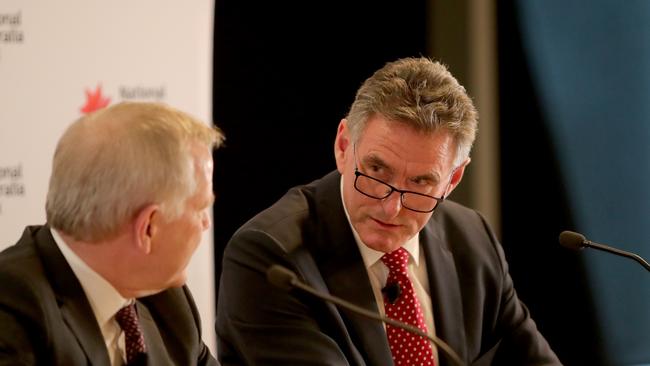NAB FY2019 profit falls 10.6pc to $5.1bn
NAB has delivered a sharp drop in full-year profit and dumped executive bonuses.

National Australia Bank has delivered a sharp drop in full-year profit to almost $5.1 billion, as customer compensation charges and lower fee income hit earnings.
NAB’s cash earnings decreased 10.6 per cent to $5.097bn for the 12 months ended September 30, compared to the same period a year earlier, the bank said in an ASX statement on Thursday. Analysts had pencilled in a profit result of $5.19bn.
Excluding large notable items NAB’s cash earnings rose 0.8 per cent in the year ended September 30.
READ MORE: Banks, super face compo costs | Zip founder Peter Gray ready for headwinds | Advice ruling will hurt consumers: Hartzer
NAB also announced that its executive leadership team would receive no short term variable remuneration and no increase to fixed remuneration. Executives had been eligible for short term bonuses of up $14.4m, the bank said. That action follows a mammoth 88 per cent vote against NAB’s remuneration report by shareholders in 2018 and as the board seeks to avoid a second strike at this year’s annual general meeting.
Chairman Phil Chronican, who also remains acting chief executive until early next month, said NAB had not achieved benchmarks on some financial and non-financial results in 2019.
“While we have made progress, it is not enough to be recognised in executive short-term variable reward in 2019,” he said.
NAB’s shares rallied 2.45 per cent to $28.48 in early trading on Thursday, as investors welcomed the dividend being maintained and a tight control on costs.
Mr Chronican said the 2019 year was “very challenging” as NAB took action on past compliance failings and the external operating environment weakened.
Caution on profit outlook
Asked if NAB could growth the bank’s profit in its 2020 financial year, Mr Chronican took a cautious approach given the backdrop of record low interest rates and sagging annual housing loan growth.
“It’s a pretty fine line to be honest,” he told journalists on Thursday morning. “Top line revenue growth will be hard to achieve and therefore profit growth will really be a function of how well we manage our expense base and how well we manage credit costs. I wouldn’t want to put a number on it.”
New NAB CEO Ross McEwan – the former boss of Royal Bank of Scotland - begins in the top job on December 2.
Mr Chonican also signalled further pressure on its net interest margin (NIM), a key measure of what it earns on loans minus funding costs. For 2019, the bank’s NIM declined 7 basis points to 1.78 per cent for the year. From the first-half to September 30 the NIM fell 1 basis point.
“Even if (interest) rates were just to stay where they are today, as a number of the structural elements of our balance sheet unwind and get re-priced at current rates that will have further downward pressure on net interest margins,” Mr Chronican said. “It certainly is an uphill struggle in that regard.”
CLSA analyst Ed Henning highlighted future margin pressure in a note to clients on Thursday.
“Looking forward NAB has called out a -3 basis point headwind on NIM and continued expectation of flat cost growth in FY20 unlike peers,” he said. “We have previously stated, once McEwan hits the ground we anticipate a step up in the transformation program.”
NAB declared a final dividend of 83 cents per share, fully franked. Following a cut in the interim dividend to 83 cents per share the year’s total payments were 16 per cent lower than the bank’s 2018 year.
Capital requirements
NAB will conduct another discounted underwritten dividend reinvestment which will see its capital ratio up to 10.75 per cent and Mr Chronican said that would increase further to 11 per cent by March.
Its common equity tier one ratio printed at 10.38 per cent as at September 30, compared to the banking regulator’s 10.5 per cent “unquestionably strong” threshold which comes into effect on January 1. NAB’s capital ratio was buoyed by $1 billion received in July from an underwritten dividend reinvestment plan.
“We think that (increase in capital) gives us lots of comfort,” Mr Chronican said, when asked if the dividend reinvestment plan erased the need to issue more shares via a capital raising.
In early October, NAB outlined additional customer compensation costs as it tallied up the cost of a string of scandals including charging fees to customers when services were not provided. The customer remediation charges in the second half amounted to $1.19bn before tax, with the lion’s share reflecting the bank’s wealth and insurance operations.
NAB’s accounts noted the bank had 950 working solely on remediating customers in its 2019 year.
Former boss Andrew Thorburn and outgoing chairman Ken Henry were victims of the bank’s poor showing at the Hayne royal commission.

NAB’s full-year accounts follow results by Westpac on Monday and ANZ bank last week, with the trio all warning of a difficult operating climate in their 2020 year. Commonwealth Bank delivers a trading update to investors next week.
Net operating income fell 4.2 per cent for the year, but was broadly flat from the bank’s first-half to the latter six month period. Net interest income edged up slightly but other operating income, which includes fees, slumped 18.4 per cent.
Mr Chronican’s outlook statement noted lower domestic economic growth in 2020, with expectations it will print at about 2 per cent.
He said housing credit growth was “likely to remain weak” and stimulus from further official cuts to interest rates were “uncertain”.
Mr Chronican said NAB’s home loan growth had disappointed in its latter half, trailing its rivals, but in the past four to six weeks application numbers showed “strong momentum”.
Three of NAB’s four business units posted a decline in cash earnings for the year ended September.
Revenue in NAB’s largest division, its business and private bank, increased 1 per cent on lending to small business. But earnings were 2.4 per cent lower due to higher credit impairments and investment spend.
NAB’s consumer bank and wealth unit saw cash earnings tumble 11.2 per cent as lower margins and competitive pressures took a toll. The corporate and instutional bank posted earnings that were 2.1 per cent lower.
The New Zealand unit was the outlier posting a 5.1 per cent jump in cash earnings on growth in in lending.
Mr Chonican also reiterated that NAB remains committed to selling or spinning off wealth unit MLC in calendar 2020.
On pay, Westpac chief Brian Hartzer gave up his 2019 short-term bonus, while ANZ chief Shayne Elliott took a cut in his short term incentive.





To join the conversation, please log in. Don't have an account? Register
Join the conversation, you are commenting as Logout